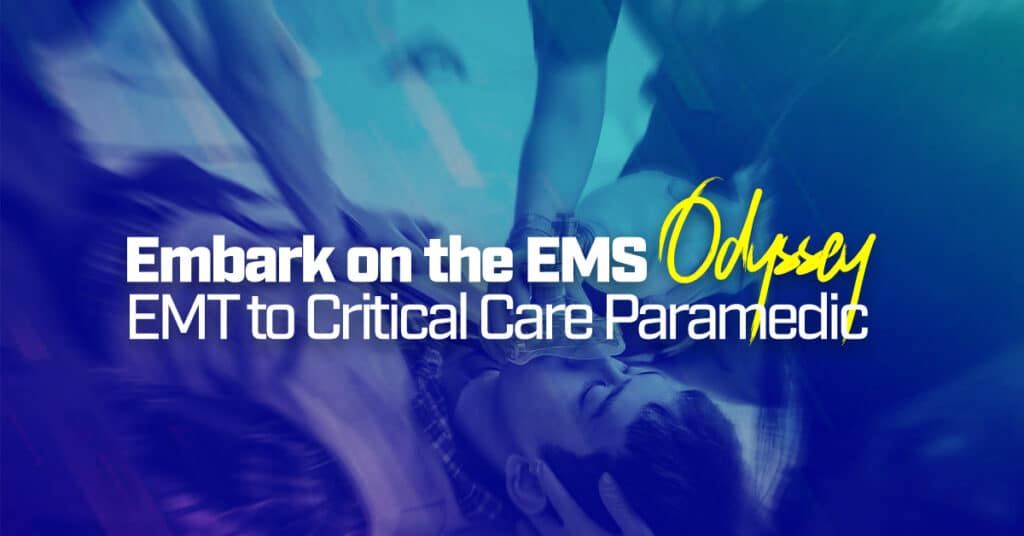Embark on the EMS Odyssey: EMT to Critical Care Paramedic

The realm of emergency medical services (EMS) is one of constant evolution, where professionals are continually called upon to enhance their skills, knowledge, and expertise. The transition from an EMT to a Critical Care Paramedic epitomizes this commitment to growth and excellence. This journey, enriched by mentorship and continuous learning, is both challenging and rewarding.
The Significance of Continuous Learning in EMS
The medical landscape is ever-changing, with new research, techniques, and technologies emerging regularly. For EMS professionals, adapting to these changes is not just a matter of professional growth but a commitment to delivering the best patient care. “EMS providers must respond to emergencies of all kinds, and care for patients across the age spectrum. EMS providers spend the majority of their time caring for adults, though their impact on pediatric patients is potentially great. One child dies every hour in the US due to an injury with automobile accidents, suffocation, drowning, poisoning, fires, and falls being the most common causes of injuries. EMS providers are often the first point of contact with the healthcare system for these children and they have the potential to save lives as well as limit pain and suffering” (Hansen et al., 2015).
Staying Updated with Medical Advancements
As new diseases emerge and medical protocols change, EMS professionals must stay updated to provide the best care. This requires a commitment to continuous learning, ensuring they are equipped with the latest knowledge and techniques. “Though the potential impact of EMS care is high, there is also the potential for knowledge gaps among EMS providers in pediatric care. Children represent between 4% and 13% of EMS transports, and critically ill children are infrequently seen by any individual provider” (Hansen et al., 2015).
Diverse Learning Platforms
The digital age has revolutionized learning. EMS professionals can now access a plethora of online courses, webinars, and workshops, allowing them to learn at their own pace and convenience. These platforms offer a blend of theoretical knowledge and practical insights, ensuring a holistic learning experience.
Practical Skill Enhancement
EMS is a hands-on profession. While theoretical knowledge is essential, the ability to apply this knowledge in real-world scenarios is crucial. Simulation-based training, practical workshops, and on-field training sessions play a pivotal role in honing these practical skills.
The Transformative Power of Mentorship
In the challenging world of EMS, where split-second decisions can mean the difference between life and death, the guidance of a seasoned professional can be invaluable.
Mentorship: Beyond Teaching
A mentor offers more than just knowledge. They provide guidance, support, and, most importantly, perspective. They share their experiences, challenges, and learnings, offering a roadmap to success.
Finding the Right Mentor
The journey in EMS is personal, and so is mentorship. It’s essential to find a mentor whose journey resonates with yours. Professionals like Eric Bauer, Ashley Bauer, Bruce Hoffman, Mike Verkest, and Chris Meeks from FlightBridgeED have been guiding lights for many, helping them navigate the complexities of EMS.
The Reciprocity of Mentorship
While mentees gain insights and guidance, mentors benefit from fresh perspectives, challenges, and the sheer joy of seeing their mentees succeed. It’s a relationship built on trust, respect, and mutual growth.
FlightBridgeED: A Legacy of Excellence in EMS Education
Education is the cornerstone of professional growth, and FlightBridgeED has been at the forefront of EMS education, setting benchmarks of excellence.
A Comprehensive Curriculum
FlightBridgeED’s courses are meticulously designed, keeping in mind the diverse needs of EMS professionals. From foundational courses for beginners to advanced modules for seasoned professionals, the curriculum caters to all. “A more rigorous and inclusive educational needs assessment is critical in order to refine content in EMS training programs to target the most immediate needs, refine existing continuing education programs, as well as inform [the] design of new curricula” (Hansen et al., 2015).
A Community of Learners
Beyond courses, FlightBridgeED has fostered a community where professionals from across the globe come together to learn, share, and grow. This collaborative environment enriches the learning experience, with professionals sharing real-world experiences, challenges, and insights.
Looking Ahead
The future holds exciting possibilities for EMS. As the field evolves, FlightBridgeED is committed to staying ahead of the curve, integrating the latest research, techniques, and technologies into our courses!
Among the standout offerings from FlightBridgeED that can help you achieve your goals is the ARC+ course, designed to not only advance your career but also to delve deep into advanced topics in critical care transport medicine. Not only that, but it’s a fantastic way to get all the CE hours you need to recertify!
The journey from an EMT to a Critical Care Paramedic is a reflection of one’s dedication to the noble profession of EMS. It’s a journey of growth, learning, and continuous evolution. With the right guidance, resources, and an unwavering commitment to excellence, this journey can be incredibly fulfilling. FlightBridgeED, with its legacy of excellence, stands as a beacon for all those aspiring to reach the pinnacle of success in EMS.
References
Hansen, M., Meckler, G., Dickinson, C., Dickenson, K., Jui, J., Lambert, W., … & Guise, J. M. (2015). Children’s Safety Initiative: A National Assessment of Pediatric Educational Needs among Emergency Medical Services Providers. Prehospital Emergency Care, 19(2), 287-291.
